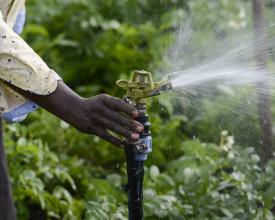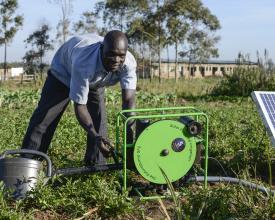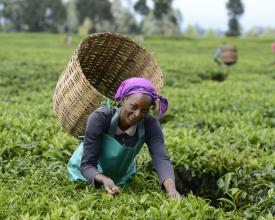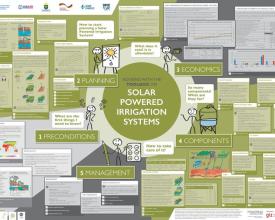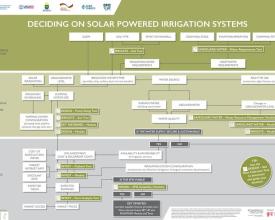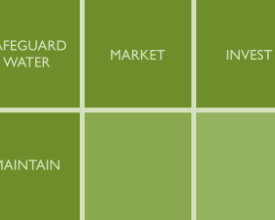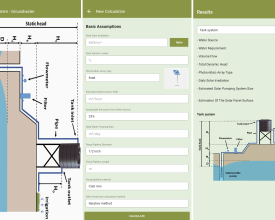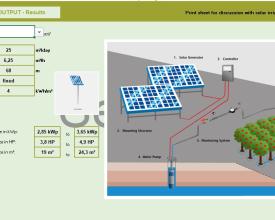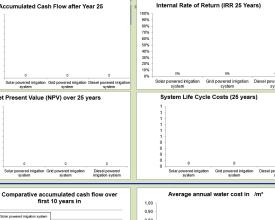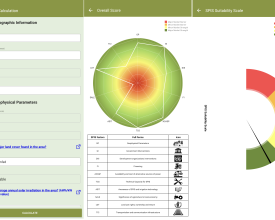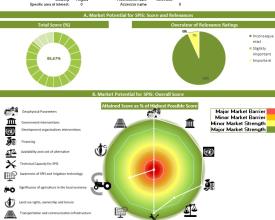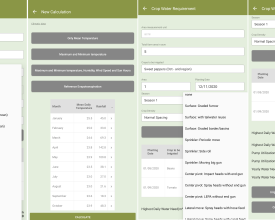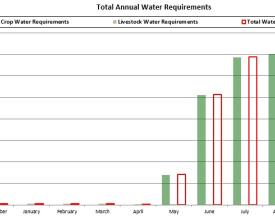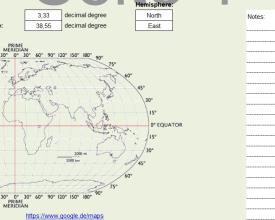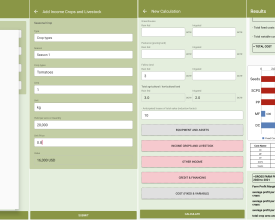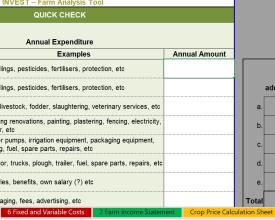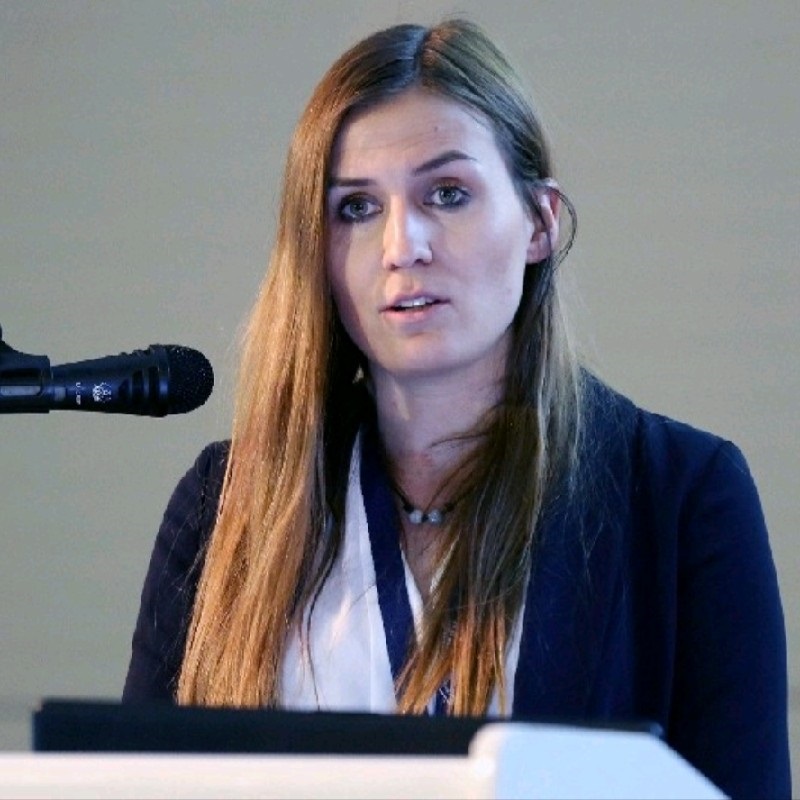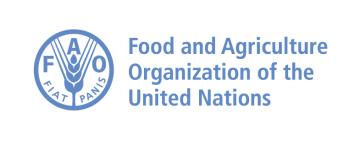
Boîte à outils sur les systèmes d'irrigation à énergie solaire (SPIS) : Informations et outils pour conseiller sur le pompage solaire de l'eau et l'irrigation
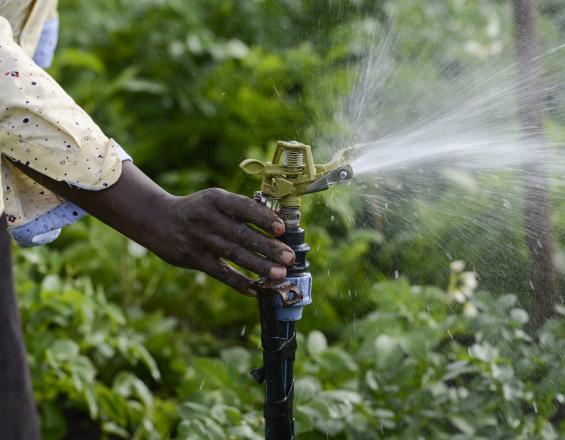
Les pompes solaires sont devenues une alternative économique, techniquement et écologiquement viable aux systèmes de pompage conventionnels alimentés par des moteurs fonctionnant aux combustibles fossiles (diesel, essence, gaz) ou à l'électricité provenant du réseau, même dans les zones rurales où l'approvisionnement en électricité est limité ou inexistant.
La boîte à outils sur les systèmes d'irrigation solaire est conçue pour permettre aux conseillers, aux prestataires de services et aux praticiens dans le domaine de l'irrigation solaire de fournir des conseils pratiques aux utilisateurs finaux, aux décideurs politiques et aux financiers. L'ensemble holistique de produits de connaissances pratiques, que la boîte à outils fournit, permet aux utilisateurs finaux de prendre en compte les caractéristiques spécifiques des systèmes d'irrigation solaire et de minimiser les risques liés à l'efficacité du système, à la viabilité financière et à l'utilisation non durable de l'eau.
La boîte à outils comprend des modules d'information complétés par des outils logiciels conviviaux (feuilles de calcul, listes de contrôle, lignes directrices) qui aident les utilisateurs à budgétiser, dimensionner et concevoir un système d'irrigation alimenté par l'énergie solaire. Les outils sont disponibles en anglais, français, espagnol et arabe.
Contexte
Défis à relever
Le manque d'informations sur l'irrigation solaire et les coûts d'investissement relativement élevés entravent l'adoption de cette technologie. Les connaissances sur le potentiel, les limites et les risques de l'irrigation solaire parmi les agents de vulgarisation, les fournisseurs, les décideurs politiques, les institutions de financement et les autres parties prenantes doivent être étendues. Ainsi, les agriculteurs auront accès à des informations fiables leur permettant de prendre des décisions éclairées et d'entretenir un système d'irrigation spontanée de manière durable. La boîte à outils fournit une approche holistique grâce à laquelle les conseillers SPIS peuvent guider leurs clients.
La boîte à outils SPIS améliore la capacité des agriculteurs, des conseillers et des installateurs de systèmes à gérer durablement les ressources en eau dans un système SPIS. L'accès à l'information sur les systèmes SPIS contribue à une adoption plus large de la technologie et à une réduction des émissions grâce à l'utilisation de l'énergie solaire au lieu des combustibles fossiles pour alimenter les pompes.
La boîte à outils informe les organismes décisionnaires sur l'option financière la mieux adaptée aux besoins des agriculteurs, de sorte que ces derniers puissent accéder au financement de l'IAE.
Emplacement
Traiter
Résumé du processus
Il est important de concevoir le SPIS de manière à répondre aux besoins des agriculteurs et aux conditions spécifiques du site (leurs aspects environnementaux, agronomiques et techniques). Cela permet d'optimiser le potentiel de la technologie et d'éviter les impacts écologiques et économiques négatifs. La boîte à outils comble le manque de connaissances en informant les agents de vulgarisation, les fournisseurs, les décideurs politiques, les institutions de financement et les autres parties prenantes sur le potentiel, les limites et les risques des systèmes d'irrigation à énergie solaire (SPIS). La boîte à outils comprend des modules d'information complétés par des outils logiciels conviviaux (feuilles de calcul, listes de contrôle, lignes directrices) qui fournissent un ensemble holistique de connaissances pratiques grâce auxquelles les conseillers SPIS peuvent guider leurs clients vers un choix financièrement et écologiquement rationnel qui permet d'économiser l'eau, d'atteindre une productivité plus élevée par unité d'eau consommée tout en fournissant de l'eau à l'environnement.
Blocs de construction
L'outil de dimensionnement des pompes
L'outil de dimensionnement des pompes permet de calculer la hauteur de pompage, la capacité requise du module solaire photovoltaïque et de sélectionner les technologies de pompage appropriées. L'outil DESIGN - Pump Sizing Tool aide à concevoir le système d'irrigation de manière à garantir une perte de pression aussi faible que possible dans le système. En outre, il sert de liste de contrôle pour identifier les pertes de pression, dues par exemple à des fuites dans un système existant.
Facteurs favorables
Soutien technique aux agriculteurs pendant la phase de planification ; données sur les besoins quotidiens en eau des cultures, le rayonnement solaire global quotidien moyen pour le mois de référence, les coûts spécifiques au pays du panneau photovoltaïque et de la pompe ; disponibilité des options de financement.
Leçon apprise
Il est essentiel de dimensionner correctement les composants d'un SPIS, car un SPIS de capacité insuffisante ne répondra pas aux besoins des agriculteurs et un système surdimensionné entraînera des coûts d'exploitation et d'investissement inutiles. La négligence du rendement durable des sources d'eau peut entraîner une pénurie d'eau et un épuisement des ressources en eau, ce qui a des répercussions négatives sur le budget de l'exploitation et sur l'environnement. Il est donc très important d'être en contact étroit avec l'agriculteur pendant la phase de planification et de l'informer des avantages et des limites du système SPIS.
La conception finale de la pompe PV et du système d'irrigation doit être confiée à des intégrateurs de systèmes expérimentés qui utilisent des outils informatiques de dimensionnement et de simulation tels que COMPASS, WinCAPS et PVSYST, HydroCALC, GESTAR.
L'outil de récupération
L'outil d'amortissement permet une évaluation comparative des revenus et de trois options différentes de pompage pour l'irrigation. Les informations nécessaires à l'utilisation de cet outil comprennent les coûts d'investissement et de fonctionnement des différents systèmes de pompage, le revenu anticipé de la production agricole et les conditions économiques de base (par exemple, le taux d'inflation). Même si la rentabilité de l'entreprise agricole est confirmée, cela n'implique pas automatiquement qu'un investissement dans un SPIS soit le choix le plus judicieux. Cela est particulièrement vrai si d'autres technologies de pompage sont facilement disponibles sur le marché. Une pompe diesel ou une pompe électrique connectée au réseau peut être plus appropriée lorsque le pompage de l'eau n'est nécessaire que pendant une période limitée de l'année. L'outil INVEST - Payback Tool étudie et compare les systèmes d'irrigation alimentés par l'énergie solaire avec d'autres technologies de pompage. Les données de base sont collectées auprès des fournisseurs de technologies et la période de récupération par rapport aux bénéfices de l'exploitation et aux différentes technologies est automatiquement calculée.
Facteurs favorables
Disponibilité de données sur la durée de vie fonctionnelle du projet/SPIS, les dépenses d'investissement/les investissements initiaux pour les options solaires et alternatives, les prix du marché, les coûts d'exploitation et de maintenance, les variables macroéconomiques, les politiques fiscales ; avis complémentaires d'experts financiers.
Leçon apprise
Tous les calculs doivent être basés sur des prix qui peuvent être déterminés, mais aussi sur des estimations et des hypothèses. Ils devront prendre en compte la situation actuelle et les scénarios futurs et devront comparer les options de systèmes de pompage alternatifs (électrique, diesel). Différents scénarios doivent être élaborés avant de prendre une décision.
L'outil d'évaluation du marché
L'outil d'évaluation du marché prend en compte les paramètres géophysiques de base et fournit des lignes directrices et des pondérations pour évaluer les paramètres qui informent un environnement commercial favorable pour les SPIS. L'outil d'évaluation du marché vise à fournir des informations conduisant à des évaluations du potentiel du marché pour les systèmes d'irrigation alimentés par l'énergie solaire dans un pays ou une région. Il fournit des paramètres à prendre en considération qui peuvent être appliqués par différentes parties prenantes (y compris les entreprises privées de SPIS, les décideurs politiques, les institutions financières et les praticiens du développement) dans l'évaluation du potentiel de marché des SPIS.Les paramètres utilisés pour évaluer le potentiel du marché comprennent des paramètres géophysiques tels que l'irradiation solaire, les précipitations, l'occupation et l'utilisation des sols, et des paramètres de l'environnement commercial (tels que les interventions du gouvernement, les interventions des organisations de développement, le financement, la disponibilité, la qualité de l'eau, etc,Interventions des organisations de développement, financement, disponibilité et coût des combustibles alternatifs, capacité technique, sensibilisation à la technologie photovoltaïque, importance de l'agriculture dans l'économie locale, accès à la terre et régime foncier, infrastructures de transport et de communication).
Facteurs favorables
Données précises sur les précipitations, l'occupation et l'utilisation des sols et l'irradiation solaire ; vérification sur le terrain
Leçon apprise
L'identification des marchés cibles pour les SPIS implique l'évaluation de nombreux paramètres. Il peut s'agir de divers paramètres géophysiques et d'environnement commercial. Pour les parties prenantes qui n'ont pas de marché cible en tête ou qui souhaitent simplement avoir une vue d'ensemble des domaines potentiels dans lesquels des systèmes pourraient être mis en place ou utilisés, cette tâche peut s'avérer décourageante et chronophage.
Lors de l'évaluation du potentiel de marché pour les systèmes d'irrigation à petite échelle, les parties prenantes doivent évaluer la viabilité de l'irrigation de leur site cible du point de vue de l'occupation et de l'utilisation des sols. Il est toujours important de faire suivre l'analyse documentaire de l'occupation des sols par des visites réelles sur le terrain dans les zones sélectionnées.
L'installation de panneaux solaires dans des régions à faible rayonnement solaire pourrait entraîner des coûts d'installation élevés en raison de l'utilisation d'un plus grand nombre de panneaux. En raison des progrès technologiques, le rayonnement solaire est davantage une considération économique qu'une question de faisabilité technique.
L'outil de calcul des besoins en eau
L'outil de calcul des besoins en eau calcule les besoins en eau pour une variété de cultures et de bétail en fonction de paramètres géographiques et climatiques, aidant ainsi les conseillers et les agriculteurs à évaluer la quantité d'eau nécessaire pour le système d'irrigation. Il aide les conseillers et les agriculteurs à évaluer la quantité d'eau nécessaire au système d'irrigation, ce qui permet d'éviter un pompage excessif et une irrigation insuffisante.
Facteurs favorables
Données locales sur les besoins en eau des cultures, les précipitations mensuelles, les masses d'eau de surface et les systèmes aquifères souterrains, les droits de licence et de prélèvement d'eau et les débits des sources d'eau ; ressources fournies (par exemple, par la FAO).
Leçon apprise
Un pompage excessif peut entraîner l'épuisement des eaux souterraines. Cela signifie que les eaux souterraines sont extraites à un rythme plus rapide qu'elles ne peuvent être reconstituées. L'épuisement des aquifères peut entraîner la perte d'écosystèmes et de zones humides, l'augmentation des émissions de gaz à effet de serre, l'affaissement des sols et des conflits sociaux avec d'autres utilisateurs d'eau. Tout développement de SPIS doit donc être intégré dans les cadres juridiques et réglementaires en vigueur et dans la planification et le suivi de la gestion locale de l'eau et des eaux souterraines.
L'outil d'analyse des exploitations agricoles
L'outil d'analyse agricole permet d'évaluer la rentabilité d'une exploitation agricole. Il fournit des feuilles de saisie pour ajouter les différentes dépenses et revenus de l'exploitation et calcule automatiquement la marge bénéficiaire de l'exploitation. Il met également en évidence les coûts fixes et variables les plus importants et les domaines dans lesquels des économies pourraient avoir un impact significatif. L'outil génère un compte de résultat agricole qui peut être présenté à un établissement de crédit. Cet outil est utile pour :
- Déterminer le niveau actuel de rentabilité (ligne de base avant investissement) ;
- Déterminer la rentabilité anticipée de l'investissement (projection post-investissement).
Facteurs favorables
Disponibilité de données sur les modèles de culture, les techniques d'irrigation, les systèmes de pompage, les autres solutions de pompage disponibles, le marché, les produits de prêt actuels disponibles pour les clients potentiels de SPIS,le régime d'approvisionnement en eau et en énergie dans la région, les structures de soutien/conseil et les régimes de subvention disponibles dans la région, l'évaluation de l'impact environnemental à long terme ; une réévaluation annuelle de la rentabilité de l'exploitation.
Leçon apprise
Un système d'irrigation solaire (SPIS) est généralement un choix d'investissement à long terme visant à réduire les dépenses d'exploitation de l'exploitation ou à augmenter la productivité agricole, ou les deux à la fois.
Même lorsque la rentabilité de l'entreprise agricole est confirmée, cela n'implique pas automatiquement qu'un investissement dans un système de pompage soit le choix le plus judicieux. Cela est d'autant plus vrai si d'autres technologies de pompage sont disponibles sur le marché. Une pompe diesel ou une pompe électrique connectée au réseau peut être plus appropriée lorsque le pompage de l'eau n'est nécessaire que pendant une période limitée de l'année. L'outil Payback peut vous aider à prendre cette décision.
Impacts
Le manque d'informations sur l'irrigation solaire et les coûts d'investissement relativement élevés sont les principaux obstacles à l'adoption de cette technologie. Les connaissances sur le potentiel, les limites et les risques des systèmes d'irrigation à énergie solaire (SPIS) sont incomplètes parmi les agents de vulgarisation, les fournisseurs, les décideurs politiques, les institutions de financement et les autres parties prenantes. Par conséquent, les agriculteurs, qui constituent le principal groupe d'utilisateurs finaux, ont du mal à obtenir des informations fiables leur permettant de prendre des décisions en connaissance de cause et d'entretenir un système d'irrigation solaire de manière durable.
La boîte à outils comble le manque de connaissances en fournissant un ensemble holistique de matériel de connaissances pratiques grâce auquel les conseillers SPIS peuvent guider leurs clients vers un choix financièrement et écologiquement sain. Les décisions fondées sur l'utilisation de la boîte à outils permettent d'éviter les impacts écologiques et économiques négatifs en optimisant le SPIS en fonction des besoins des agriculteurs et des conditions environnementales et agronomiques spécifiques au site, y compris les aspects techniques. Jusqu'à présent, la GIZ a formé plus de 500 parties prenantes, décideurs et conseillers dans le monde entier.
La boîte à outils comprend 10 modules et 16 outils qui aident les utilisateurs à budgétiser, dimensionner et concevoir un système d'irrigation solaire. Grâce à la boîte à outils, les utilisateurs finaux économisent de l'eau et obtiennent une meilleure productivité par unité d'eau consommée, tout en fournissant de l'eau à l'environnement. Il en résulte une amélioration de la sécurité alimentaire, de la gestion de l'eau et une augmentation des revenus des agriculteurs.
Bénéficiaires
La boîte à outils est conçue pour permettre aux conseillers, aux prestataires de services et aux praticiens dans le domaine de l'irrigation solaire de consulter les utilisateurs finaux, en particulier les petits exploitants agricoles et les coopératives.
Objectifs de développement durable
Histoire
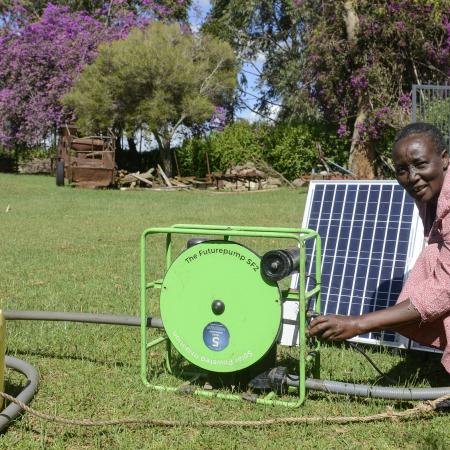
Depuis 2015, la boîte à outils est passée d'un simple outil Excel à une expérience d'apprentissage complète disponible en anglais, en français, en espagnol et en arabe. Elle comprend des modules de formation éprouvés, un cours d'apprentissage en ligne, des vidéos d'instruction en ligne et un pool de formateurs qui ont eux-mêmes été formés par l'équipe de Powering Agriculture. Ainsi, la boîte à outils offre différentes voies d'apprentissage.
Dès le départ, l'idée était de proposer des formations dans le cadre d'un projet ou de programmes d'études plus larges. La boîte à outils a été intégrée dans les programmes de formation de plusieurs organisations. Au fur et à mesure que l'intérêt pour la boîte à outils grandissait, il est devenu évident qu'un réseau de formateurs plus systématique et durable était nécessaire. La première étape en ce sens a été une collaboration avec Women in Sustainable Energy and Entrepreneurship (WISEe) au Kenya.
Comme dans beaucoup d'autres pays, l'adoption des énergies renouvelables au Kenya est entravée par l'insuffisance de l'assistance technique aux ménages ruraux. Au Kenya, les rares praticiens qualifiés dans le domaine de l'énergie solaire photovoltaïque se trouvent principalement dans les grands centres urbains. De plus, il y a peu de femmes techniciennes. Pour combler cette lacune, WISEe a formé des femmes aux compétences techniques de base en matière de photovoltaïque, en leur donnant les moyens d'éduquer les autres, en développant leurs compétences entrepreneuriales pour créer leur propre entreprise et en faisant d'elles des championnes des technologies solaires.
"Le développement des capacités est essentiel, car il permet de s'assurer que les informations sur l'irrigation solaire parviennent aux praticiens et aux utilisateurs finaux plutôt que de rester dans le domaine des fabricants d'équipement, des fournisseurs et des experts", explique Jacinta Gatwiri, l'une des femmes formées par WISE.
Après un atelier de formation des formateurs de cinq jours, cinq femmes ont été invitées à participer aux ateliers de formation SPIS et à les diriger. Les formatrices de WISEe peuvent désormais proposer leurs compétences nouvellement acquises aux organisations intéressées. Le fait que WISEe ait été conçu et soit géré par des femmes pour renforcer les capacités des femmes dans un secteur largement dominé par les hommes en fait un catalyseur de changement.
Jacinta Gatwiri et ses collègues ont déjà organisé de nombreuses formations sur l'irrigation à l'énergie solaire au Kenya et dans d'autres pays pour le compte de la GIZ et de la FAO. "J'ai apprécié l'utilisation de méthodes d'enseignement flexibles et le fait que les stagiaires puissent suggérer des modifications pour répondre à leurs besoins locaux sur la base de leurs expériences sur le terrain", se souvient la présidente de WISEe. Le renforcement des capacités au niveau local permet d'améliorer la collaboration et le travail en réseau entre les personnes formées.
